Figure 3.

J is inserted into some plasmids transfected in L. tarentolae. The 25.2S, 25.2L and 28.2 plasmids, shown in Figure 2, were purified after amplification in L. tarentolae or E. coli. The DNA samples were digested with BamHI, EcoRI and XbaI, size-fractionated in a 0.7% agarose gel in 0.5×TBE, transferred to nitrocellulose and incubated with an anti-J antibody. (A) The plasmids 25.2L and 25.2S purified from L. tarentolae show specific bands recognized by the anti-J antibody. It is clear that J was not only formed in the inserted 2 kb 25.2L cSSR, but also in the adjacent 0.8 kb intergenic α-tubulin and the 1.7 kb α-tubulin-neo fragments. The small 25.2S insert fragment is not visible on the blot. No J-containing fragments are detected when the plasmids were isolated from E. coli or when the 28.2 plasmid was used. (B) J-containing DNA fragments are only detected after growth in the wild-type and not after growth in the JBP2-null L. tarentolae strain. This blot contains the 0.4 kb 25.2S insert band, albeit weak because these small fragments are lost during blotting. The 1.2 kb fragment in the 25.2S plasmid preparation is due to a modification of the BamHI site.
